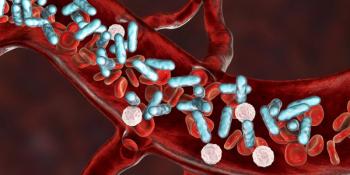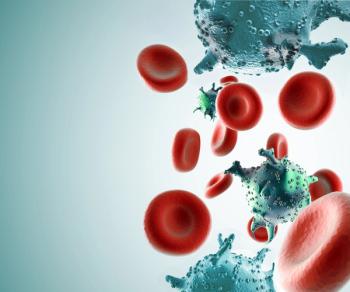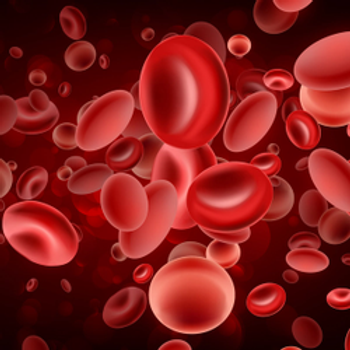
Pembrolizumab Combo Improves pCR Rate in Advanced Gastric/GEJ Cancer
Data from KEYNOTE-585 showed that adding pembrolizumab to chemotherapy did not negatively impact health-related quality of life vs placebo/chemotherapy.
Combining perioperative pembrolizumab (Keytruda) with chemotherapy numerically improved pathological complete responses (pCRs) and showed a trend towards longer event-free survival (EFS) vs chemotherapy alone in patients with advanced gastric or gastroesophageal junction (GEJ) adenocarcinoma, according to findings from the final analysis of the phase 3 KEYNOTE-585 trial (NCT03221426) published in Journal of Clinical Oncology.1
Across the main cohort, pembrolizumab plus chemotherapy elicited a pCR rate of 13.4% (n = 54/402; 95% CI, 10.3%-17.2%) compared with 2.0% (n = 8/402) among those who received placebo in combination with chemotherapy. Data showed that the addition of pembrolizumab consistently provided a pCR benefit across prespecified subgroups. When accounting for the main cohort plus those who received fluorouracil, leucovorin (folinic acid), oxaliplatin, and docetaxel (FLOT), the pCR rate was 14.2% (95% CI, 11.3%-17.6%) in the pembrolizumab arm vs 2.8% (95% CI, 1.6%-4.7%) in the placebo arm.
The median EFS in the main cohort was 44.4 months (95% CI, 33.0-69.8) with the pembrolizumab combination and 25.7 months (95% CI, 20.8-36.5) in the placebo arm, with respective 5-year EFS rates of 47% vs 37% (HR, 0.81; 95% CI, 0.67-0.98). In the main plus FLOT population, the median EFS was 47.0 months (95% CI, 36.2-not reached [NR]) vs 26.9 months (95% CI, 22.1-34.7) in each arm, with corresponding 5-year rates of 48% vs 38% (HR, 0.80; 95% CI, 0.67-0.95).
In the main cohort, the median overall survival (OS) was 71.8 months (95% CI, 52.5-NR) with the pembrolizumab regimen vs 55.7 months (95% CI, 41.7-NR) with placebo/chemotherapy, with respective 5-year rates of 54% vs 48% (HR, 0.86; 95% CI, 0.71-1.06). The addition of pembrolizumab trended towards OS improvements in patients with microsatellite instability-high tumors and those with a PD-L1 combined positive score (CPS) of 10 or higher. Across the main plus FLOT cohort, the median OS was NR (95% CI, 59.2-NR) vs 55.7 months (95% CI, 42.8-NR) in each respective arm (HR, 0.86; 95% CI, 0.71-1.03).
“Similar results in [pCR], EFS, and OS were observed in the combined main and FLOT cohort. Although the study did not find improvement in [pCR] to be predictive of EFS or OS, the relationship between these end points should be further assessed,” lead study author Kohei Shitara, MD, from National Cancer Center Hospital East in Kashiwa, Japan, wrote in the publication with fellow coauthors.1 “To our knowledge, [KEYNOTE-585] was [the] first global study to report survival results with neoadjuvant/adjuvant PD-1 inhibitors plus chemotherapy for [patients] with locally advanced [gastric or GEJ] adenocarcinoma. Additional studies are needed to elucidate the effectiveness of checkpoint inhibitors in this setting and to further assess whether [pCR] is an effective surrogate end point for survival.”
In the double-blind KEYNOTE-585 trial, 804 patients in the main cohort were randomly assigned 1:1 to receive neoadjuvant pembrolizumab at 200 mg (n = 402) or placebo (n = 402) plus cisplatin at 80 mg/m2 intravenously, oral capecitabine at 1000 mg/m2 twice daily, or fluorouracil at 800 mg/m2 per day every 3 weeks for 3 cycles. Subsequent treatment consisted of adjuvant pembrolizumab or placebo plus chemotherapy for 3 cycles and then pembrolizumab or placebo alone once every 3 weeks for 11 cycles. The study also included a cohort of 203 patients who received chemotherapy with FLOT, which consisted of docetaxel at 50 mg/m2, oxaliplatin at 85 mg/m2, fluorouracil at 2600 mg/m2, and leucovorin at 200 mg/m2 every 2 weeks.
The trial’s primary end points were pCR per blinded independent central review, EFS per investigator evaluation using RECIST v1.1 criteria, OS in the main cohort, and safety in the FLOT cohort. Safety in the combined main and FLOT cohorts represented a secondary end point.
Patients 18 years and older with previously untreated localized gastric or GEJ adenocarcinoma, willingness to provide tissue from a tumor lesion at baseline, and an ECOG performance status of 0 or 1 within 3 days of beginning treatment were eligible for enrollment on the trial.2 Having adequate organ function and a life expectancy of more than 6 months were additional requirements for study entry.
The median age was 64 years (range, 22-90) in the pembrolizumab arm and 63 years (range, 26-84) in the placebo arm, and most patients from each arm were male (72% vs 71%). In each respective arm, most patients had an ECOG performance status of 0 (75% vs 74%), a tumor located in the stomach (79% vs 80%), stage III disease (75% vs 76%), and a PD-L1 CPS of 1 or higher (73% vs 76%).
With a median follow-up of 58.6 months (95% CI, 36.7-75.8) in the pembrolizumab arm and 58.5 months (range, 36.7-75.8) in the placebo arm for patient-reported outcomes, data showed no meaningful differences from baseline to week 6 or 39 in terms of the QLQ-C30 scales; QLQ-STO22 pain scale; or the EuroQoL 5-dimension, 5-level questionnaire visual analog scale scales. Investigators observed no new safety signals at the time of analysis, and the toxicity profile associated with the pembrolizumab combination was comparable with reports from the prior interim analysis.
References
- Shitara K, Rha SY, Wyrwicz L, et al. Pembrolizumab plus chemotherapy versus chemotherapy as perioperative therapy in locally advanced gastric and gastroesophageal junction cancer: final analysis of the randomized, phase III KEYNOTE-585 study. J Clin Oncol. Published online August 19, 2025. doi:10.1200/JCO-25-00486
- Study of pembrolizumab (MK-3475) plus chemotherapy versus placebo plus chemotherapy in participants with gastric or gastroesophageal junction (GEJ) adenocarcinoma (MK-3475-585/KEYNOTE-585). ClinicalTrials.gov. Updated July 14, 2025. Accessed August 26, 2025. https://tinyurl.com/544r288u
Newsletter
Stay up to date on recent advances in the multidisciplinary approach to cancer.

















































































